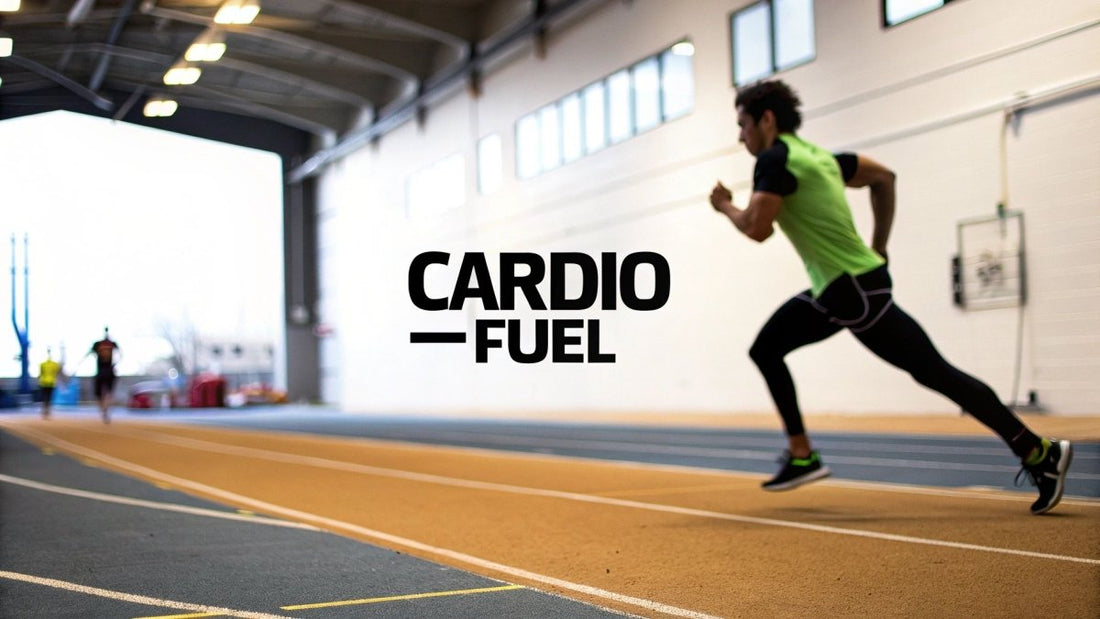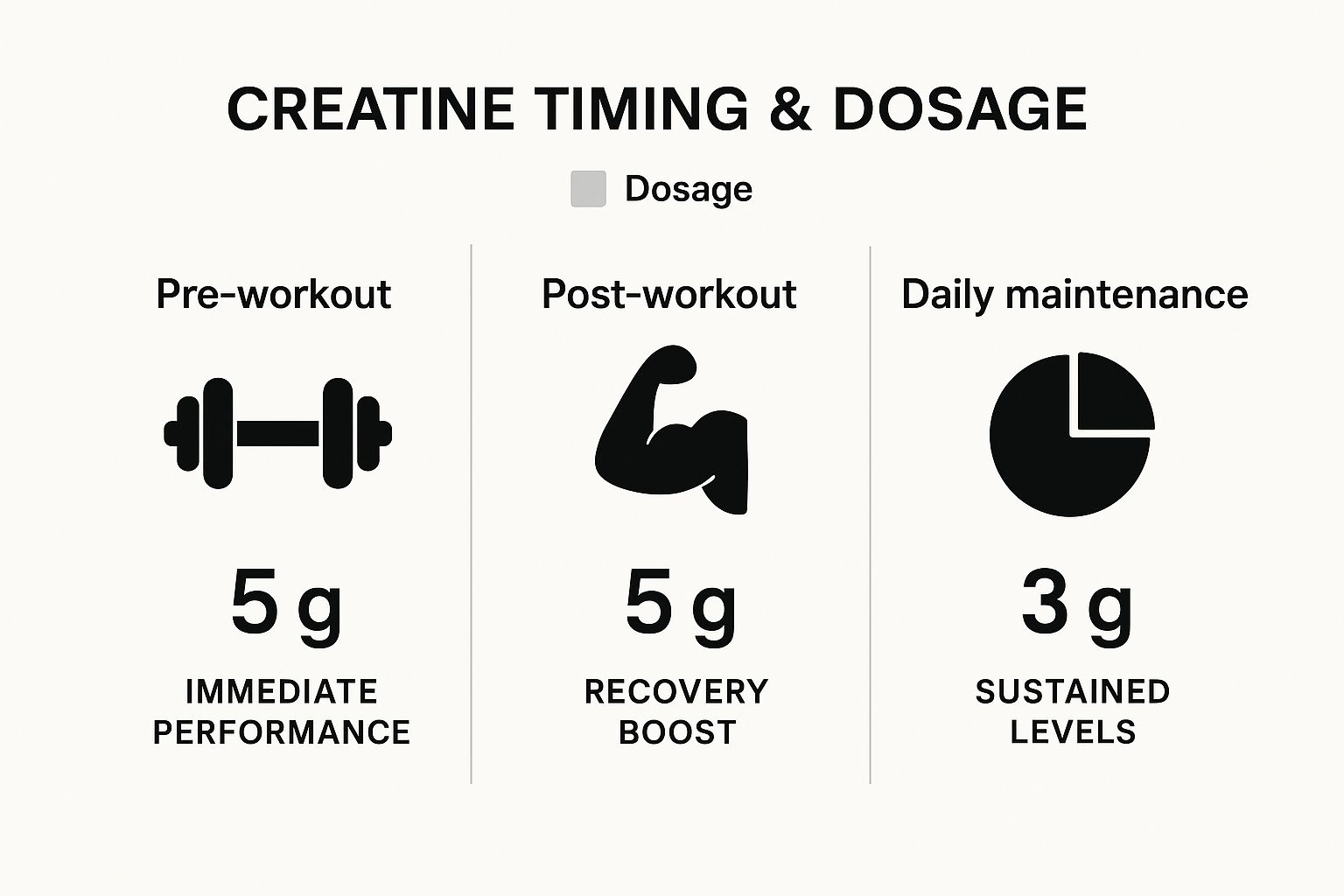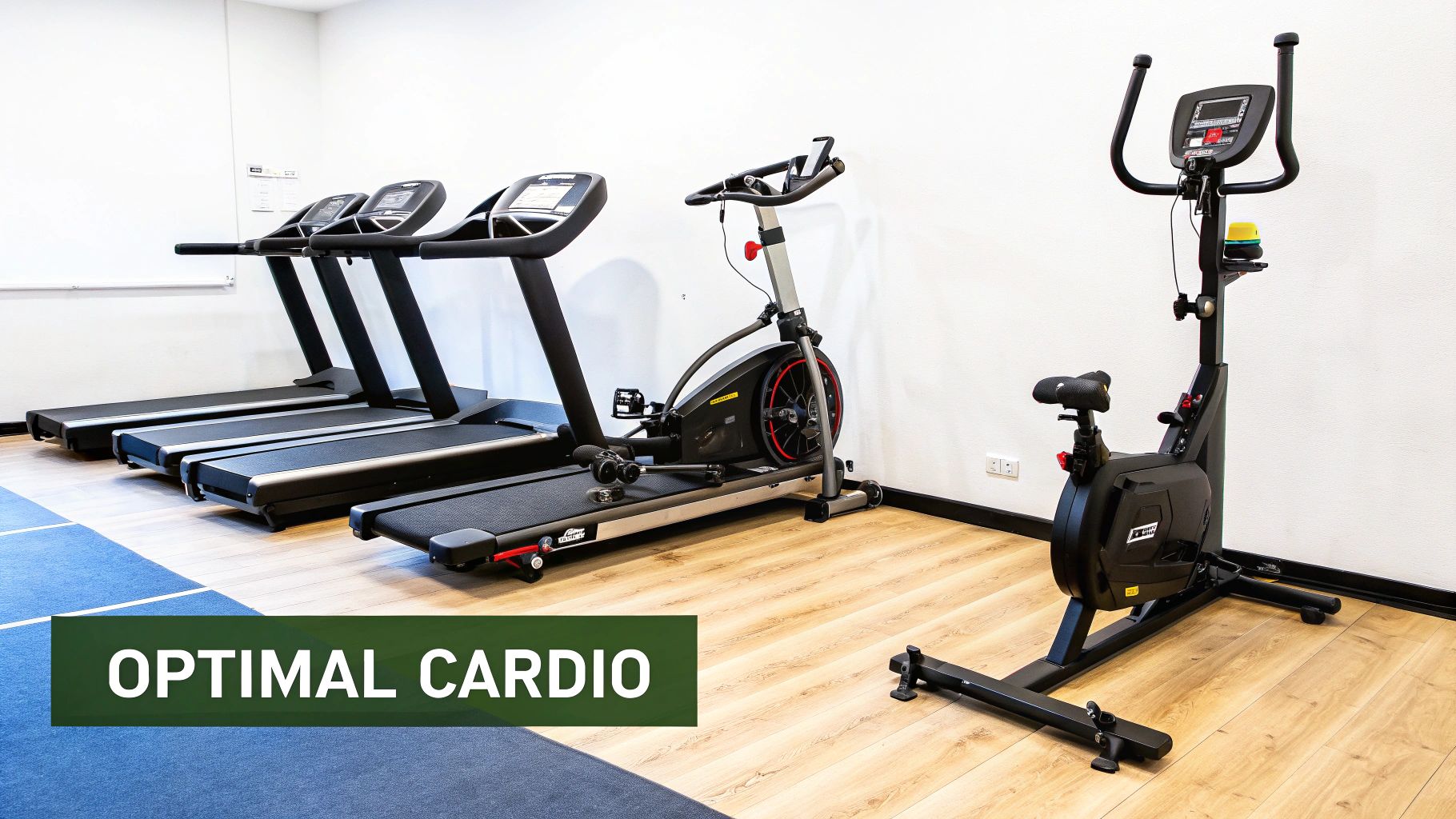
Creatine And Cardio A Performance Guide
Share
Creatine isn't just a supplement for the weight room. While it's famous for helping build muscle, its benefits for cardio are often misunderstood and overlooked. The reality is, creatine can be a powerful tool for endurance athletes, but it works differently than you might think. It’s less about going longer and more about going harder when it counts.
Think of it as a supercharger for your cells. It gives you that extra gear for the most demanding parts of your workout—the final sprint, a tough climb, or an all-out interval.
How Creatine Really Works for Cardio
For too long, creatine has been pigeonholed as a bodybuilder's supplement. This narrow view means runners, cyclists, swimmers, and other endurance-focused athletes have been missing out. When you dig into the science, you find a compelling reason for creatine and cardio to go hand-in-hand.
Let's use an analogy. Imagine your muscles are a hybrid car. You have a big gas tank for long, steady drives—that’s your fat and glycogen stores. But you also have a small, potent electric battery for quick bursts of acceleration. That’s your ATP system, your body's source of immediate, explosive energy. Creatine’s job is to rapidly recharge that battery.
During the most intense moments of cardio, like:
- A finishing kick at the end of a race
- Powering up a steep hill on your bike
- Making explosive plays in soccer or basketball
- Pushing through a brutal high-intensity interval training (HIIT) session
Your muscles drain their ATP in just a few seconds. Creatine swoops in to quickly rebuild those ATP stores, letting you maintain that high-octane output for longer and recover more quickly between efforts. It's not about adding bulk; it's about boosting your capacity for top-tier work.
Beyond a Simple Energy Boost
The story doesn't end with muscle energy. New research is showing that creatine's benefits might extend to the entire cardiovascular system. For example, a controlled 2021 study on healthy young men found that supplementing with creatine delivered some impressive cardiovascular perks.
The study observed that creatine helped blunt the rise in systolic blood pressure during intense exercise. Even better, it improved heart rate recovery five minutes after the workout was over. This suggests creatine helps your cardiovascular system handle stress more efficiently and bounce back faster. You can read more about these findings and their impact on vascular health.
The Key Takeaway: It's time to shift our perspective. Creatine isn't just for building muscle. It's a versatile performance enhancer that supercharges your body's ability to produce energy on demand, making it a game-changer for anyone serious about their cardio.
To make things even clearer, here's a quick rundown of how creatine impacts your cardio workouts.
Creatine For Cardio Quick Facts
| Area of Impact | Primary Benefit |
|---|---|
| High-Intensity Bursts | Extends your ability to sprint, climb, or surge by rapidly regenerating ATP. |
| Repeat Efforts | Speeds up recovery between intense intervals, allowing for higher quality training. |
| Lactate Threshold | May help buffer acidity in muscles, allowing you to sustain a harder pace for longer. |
| Cardiovascular Response | Can improve heart rate recovery and manage blood pressure spikes during exercise. |
| Overall Work Capacity | Increases the total volume of high-quality work you can perform in a session. |
Ultimately, creatine helps you train harder and more effectively, which is the real secret to improving your cardio performance over time.
How Creatine Fuels Your Body's Energy System

To really get why creatine can be a game-changer for your cardio, we have to look under the hood at your body's energy engine. Don't worry, this isn't a dense biology lesson. It's a straightforward look at how your muscles get the juice they need when you're pushing them to their limit.
Everything your body does—from a simple blink to an all-out sprint—runs on one specific molecule: Adenosine Triphosphate, or ATP.
Think of ATP as the highest-octane fuel for your muscles. It’s what powers every single forceful, explosive contraction. The catch? Your body only keeps a tiny bit of it on hand, just enough for a few seconds of maximum effort. It’s like the fuel tank in a drag racer—it provides an incredible burst off the line but runs dry almost immediately.
This is exactly where creatine steps in, acting like the world's fastest pit crew for your energy system.
The Rapid Refueling Process
When your muscles burn through ATP, it loses a piece (a phosphate group) and becomes Adenosine Diphosphate (ADP). You can think of ADP as an empty, useless fuel can. That's where creatine, which your body stores as phosphocreatine, saves the day. Phosphocreatine is basically just creatine holding onto a spare phosphate molecule, ready to donate it.
When that useless ADP shows up, phosphocreatine hands over its phosphate, instantly recycling it back into high-energy ATP. This incredibly fast refueling cycle lets you sustain high-intensity efforts for just a bit longer than you could otherwise.
This isn’t about fueling a marathon from start to finish. It’s about having more in the tank for the moments that count. For instance, creatine gives you the fuel for:
- The final kick at the end of a 5K.
- Powering up a steep, short hill on your bike.
- Repeated sprints in a game of soccer or basketball.
By topping off your ATP stores in real-time, creatine helps you push harder, recover more quickly between bursts, and maintain a higher level of performance when your cardio gets tough.
Delaying Fatigue and Buffering the Burn
One of the coolest side effects of this efficient energy cycle is how it helps fight off fatigue. When you're working hard, your muscles start producing metabolic byproducts, like hydrogen ions, that make them more acidic. This is that "burn" you feel, and it’s what eventually forces you to slow down.
Here’s the thing: the process of using phosphocreatine to regenerate ATP actually uses up some of those hydrogen ions. It acts as a buffer, helping to delay that acidic buildup in your muscles. The result? You can hold a higher intensity for longer before that burning sensation takes over.
This buffering effect is a key reason why creatine excels in interval-style training. It helps you recover more completely between sets, allowing you to hit each new interval with more power and less residual fatigue.
And while it's often seen as a supplement for male athletes, these energy-boosting and fatigue-fighting benefits are just as powerful for women. To dive deeper into how it supports female physiology, check out our complete guide on creatine benefits for women.
Powering Anaerobic Cardio
It’s important to remember that creatine truly shines during anaerobic exercise—those short, intense bursts that don't rely on oxygen. While we often think of "cardio" as long, steady jogs (which are aerobic), most dynamic cardio workouts are a mix of both systems.
| Cardio Type | Primary Energy System | How Creatine Helps |
|---|---|---|
| High-Intensity Interval Training (HIIT) | Anaerobic | Fuels the "all-out" work periods and speeds recovery during rest. |
| Sprint Intervals (Running/Cycling) | Anaerobic | Allows for higher power output and better maintenance of speed across reps. |
| Team Sports (Soccer, Basketball) | Mixed | Powers explosive movements like jumping, cutting, and sprinting. |
| Steady-State Jogging | Aerobic | Minimal direct impact, but helps with overall training quality and recovery. |
Creatine ensures that when your workout demands you shift into high gear, the energy is right there waiting. This makes it a fantastic tool for anyone looking to improve their explosive power and repeat-sprint ability—two pillars of well-rounded cardiovascular fitness.
Real-World Performance Benefits For Endurance Athletes

Okay, the science is interesting, but what does this all mean when you're actually out there on the track, trail, or field? This is where theory gets exciting and translates into real, tangible results on race day. For endurance athletes, it all boils down to pushing harder, recovering faster, and chasing down new personal bests.
Creatine isn't just for that one big lift. Its benefits create a positive ripple effect through your entire training program. By boosting your capacity for high-intensity work, it allows you to train at a higher level—and that’s the foundation for building exceptional cardiovascular fitness over time.
Pushing Past The Lactic Acid Burn
We've all been there. That dreaded point in a workout where your muscles start screaming and your pace just plummets. That's your lactate threshold, and it's a physiological red line. Creatine can help you push that line further back.
Because it helps buffer that acidic buildup in your muscles during hard efforts, you can sustain a faster, more punishing pace for longer before fatigue forces you to back off. For a runner, that might mean holding a quicker mile split for an extra 60 seconds. For a cyclist, it's about cranking out more power on a brutal climb without completely gassing out.
Supercharging Your Sprint and Surge Capacity
Endurance sports are rarely about holding one single, monotonous pace. They’re often won or lost in moments of intense, decisive action—a cyclist surging to break away from the pack, a soccer player making a lung-busting sprint in the final minutes, or a runner unleashing a devastating finishing kick.
This is where creatine's ability to fuel repeat sprints becomes a game-changer. Since it rapidly refills your immediate energy stores, creatine lets you:
- Recover faster between intervals during a HIIT session, so you can attack each set with more power.
- Execute multiple surges in a race without emptying the tank before the final push.
- Maintain explosive power late into a workout or game when everyone else is starting to fade.
Of course, creatine is just one piece of the puzzle. Athletes can complement its effects by adopting proven strategies to build stamina for football and other high-demand sports.
The Performance Edge: Think of it this way: creatine gives you the ability to repeatedly shift into your top gear. This improved work capacity during training is what builds a stronger, faster, and more resilient endurance athlete.
Boosting Fuel Storage for the Long Haul
While creatine itself isn’t a long-haul fuel source, it plays a fascinating supporting role by helping your muscles hoard more glycogen. Glycogen is simply the carbohydrate stored in your muscles and liver, and it’s your main fuel for any sustained cardio. More glycogen is like having a bigger fuel tank.
Research has shown that when you combine creatine supplementation with your carb intake, you can significantly increase muscle glycogen stores. This extra fuel means you have more energy to burn during long training sessions and races, which can help you delay the infamous "bonk." A well-fueled athlete is an athlete who can perform better, for longer. We dive deeper into this in our complete guide on nutrition for endurance athletes.
Accelerating Recovery and Cardiac Efficiency
The benefits don't stop when your workout does. Creatine also helps reduce muscle cell damage and inflammation caused by intense exercise, which means you recover more quickly between those tough sessions. Less soreness and more readiness for your next workout lead to better training consistency—the secret sauce to long-term progress.
And it’s not just about muscles. The impact of creatine on the heart itself is an exciting area of research. One 2021 study on bodybuilders found that while creatine use was associated with a slightly higher resting heart rate (69.6 bpm vs. 61.8 bpm in non-users), it didn't negatively affect blood pressure or other key markers of heart health. This reinforces that for healthy individuals, creatine is a safe and effective tool for boosting performance from every angle. You can learn more about these cardiac findings.
Busting the Big Myths About Creatine for Cardio
Misinformation can travel a lot faster than a sprinter, and creatine has been the target of some stubborn myths for years. For endurance athletes, these rumors often create a hesitation that’s just not necessary, keeping them from a supplement that could genuinely move the needle on performance. It’s time we set the record straight.
Let’s tackle these myths head-on with some real-world science, so you can decide for yourself.
Myth 1: “Creatine Will Make Me Bulky and Slow Me Down”
The Reality: This is, without a doubt, the number one fear I hear from runners, cyclists, and swimmers. The worry is that creatine will suddenly pack on pounds of muscle and water, turning a lean endurance machine into a sluggish powerlifter. But that’s a fundamental misunderstanding of how it works.
Yes, creatine does cause your muscles to hold onto a bit more water, but it’s not the kind of water weight you’re thinking of. Creatine pulls water inside the muscle cells—a process called intracellular hydration. This is a huge plus. A well-hydrated muscle cell is a happy, high-performing cell. It functions better, recovers faster, and is far more resilient. This isn’t the puffy, under-the-skin bloat you get from a salty meal.
Any initial weight you might see on the scale is usually just a couple of pounds of functional water weight inside the muscle, not performance-killing bulk. This actually helps your muscles work better, it doesn't slow you down.
Honestly, the performance boost you get from having more readily available energy for those high-intensity bursts far outweighs any tiny blip on the scale. You’ll be able to push harder in training, and that’s what ultimately makes you faster and stronger.
Myth 2: “Creatine Causes Cramping and Dehydration”
The Reality: This one has been so thoroughly debunked it’s amazing it still hangs around. In fact, the science points in the complete opposite direction. Because creatine helps your muscle cells hang onto water, it actually improves your body’s overall hydration status and even helps you manage your temperature during a tough workout.
Think of it as giving each muscle its own personal water bottle. This improved cellular hydration can actually lower your risk of cramping, especially when you're training in the heat.
- Better Hydration: Study after study has shown that athletes taking creatine often have fewer issues with cramping and dehydration during intense training or races.
- Smarter Thermoregulation: By helping your body handle heat more efficiently, creatine can be a real ally during those long, grueling sessions where overheating is a serious risk.
So, far from being a dehydration risk, creatine is now seen as a tool that can help athletes stay better hydrated and more resilient to heat stress.
Myth 3: “Creatine is Bad for Your Kidneys”
The Reality: This is a serious-sounding claim that, thankfully, has been exhaustively researched for decades. For anyone with healthy kidneys, the verdict is crystal clear: creatine is safe. This myth likely took hold because of a simple misunderstanding. When your body breaks down creatine, it produces a byproduct called creatinine, which is one of the markers doctors look at to check kidney function.
Taking extra creatine can slightly raise your creatinine levels, but this is a completely normal and expected outcome—it’s not a sign of kidney damage. It just shows there’s more creatine being processed, not that your kidneys are failing to do their job.
Countless long-term studies, some following athletes for years, have found no evidence that creatine supplementation harms kidney function in people without pre-existing kidney disease. As one of the most studied sports supplements in history, its safety record is incredibly solid. When you stick to the recommended doses, creatine is a safe and proven way to give your cardio a boost.
Your Practical Guide To Using Creatine For Cardio
Alright, let's move from the science to the real world. We've talked about what creatine does and debunked some common myths, but how do you actually use it to get a real edge in your cardio?
The good news is, it's incredibly straightforward. There's no complicated ritual or confusing schedule to memorize. Just a few simple guidelines will get you the best results safely and effectively.
Choosing The Right Type Of Creatine
Step into any supplement shop and you'll be hit with a wall of different creatine options: HCL, buffered, ethyl ester—the list goes on. They all come with fancy labels and big promises, but decades of solid research point to one undisputed champion.
Creatine monohydrate. It’s the gold standard for a reason.
This is the most heavily researched form of creatine on the planet, with a mountain of evidence backing its effectiveness and safety. It also happens to be the most affordable. Just grab a simple, unflavored creatine monohydrate powder to avoid any unnecessary fillers or additives.
Dosing Strategies: Loading vs. Maintenance
Once you have your creatine, you have two primary ways to start. Let's break down the "loading phase" versus the "maintenance-only" approach to see which one makes sense for you.
Creatine Loading vs Maintenance Dosing Strategy
This table compares the two most common creatine dosing protocols. Neither one is better—it's all about what fits your timeline and personal preference.
| Strategy Feature | Loading Phase Protocol | Maintenance-Only Protocol |
|---|---|---|
| Daily Dose | 20 grams (split into 4 x 5g servings) | 3-5 grams (one serving) |
| Duration | 5-7 days, then switch to maintenance | Ongoing |
| Time to Saturate Muscles | ~1 week | ~3-4 weeks |
| Best For | Athletes wanting the fastest possible results before a competition or event. | Most people; those who prefer a simpler, more gradual approach. |
The key takeaway? Both paths lead to the same destination: fully saturated muscle creatine stores. One just gets you there a bit faster.
The Loading Phase: The Fast Track
The "loading phase" is all about saturating your muscles with creatine as quickly as possible. Think of it as priming the pump to feel the benefits sooner.
- The Protocol: Take 20 grams of creatine daily for 5–7 days.
- How to Do It: Splitting that 20 grams into four smaller 5-gram servings throughout the day is much easier on your stomach.
- Who It's For: This is perfect for an athlete with a competition right around the corner who wants to max out their levels fast.
Just remember, loading is completely optional. It works, but it isn't mandatory.
Straight Maintenance: The Slow and Steady Route
The simpler, more common approach is to skip loading and just start with a daily maintenance dose. It's just as effective in the long run.
- The Protocol: Take 3–5 grams of creatine every single day.
- How to Do It: Mix your dose into any drink you like—water, a smoothie, or juice. The time of day doesn't really matter.
- Who It's For: This is the best fit for most of us who aren't in a huge rush and just want a simple, sustainable routine.
Your muscles will hit full saturation in about three or four weeks. It's a more gradual climb, but you end up at the exact same peak.
Timing And Consistency: What Really Matters
People love to debate whether you should take creatine before or after a workout. But honestly? The research shows it makes very little difference. While a few studies hint at a tiny benefit for post-workout timing, it's not something most of us would ever notice.
What truly matters is consistency.
Creatine works by building up and staying in your muscles. Taking it daily is non-negotiable.

As this shows, the real power of creatine comes from keeping your levels topped off day in and day out, not from perfectly timing one single dose.
Find a time that’s easy to remember. Maybe it’s in your morning coffee, your post-run protein shake, or with your evening meal. Just make it a habit. That consistent, daily dose is the key that unlocks all the long-term performance and recovery benefits. After all, building endurance is all about consistency, and you can learn more about how to improve stamina in our dedicated guide.
Creatine's Role In Long-Term Heart Health

While creatine’s immediate impact on cardio performance is impressive, a fascinating new area of research is uncovering its potential for long-term cardiovascular health. This changes the game a bit. It positions creatine not just as a tool for a better workout today, but as a potential partner in keeping your heart healthy for the long haul.
We're starting to look past its role in just fueling muscle contractions and seeing how it supports the entire cardiovascular system—right down to the health of your blood vessels. This is where things get really interesting for anyone serious about lifelong fitness.
Supporting Flexible and Healthy Blood Vessels
Picture your circulatory system as a vast network of highways. For traffic—your blood—to flow smoothly, these highways need to be clear, flexible, and responsive. The inner lining of these highways is a super important layer of cells called the endothelium, and keeping it healthy is fundamental to good cardiovascular function.
A healthy endothelium lets blood vessels expand and contract with ease, helping to manage blood pressure and deliver oxygen and nutrients where they're needed. This function can start to decline as we get older, making the "highways" stiffer and less efficient. Emerging science, however, suggests creatine might help keep this system running like a well-oiled machine.
By improving endothelial function, creatine essentially helps maintain the plumbing of your cardiovascular system. This proactive support can be a significant factor in promoting heart health as you get older.
One pilot study, for instance, looked at healthy older adults and found that just four weeks of creatine supplementation led to noticeable improvements in vascular endothelial function. What's really telling is that the researchers compared this improvement to the effects of well-known interventions like eating blueberries or taking Coenzyme Q10. You can learn more about creatine's effect on vascular health in that study.
Enhancing Cardiac Efficiency and Recovery
It's not just about the blood vessels, either. Creatine might also improve how efficiently your heart works, especially under stress. A well-conditioned heart doesn't just beat strong; it recovers quickly after you push it hard. The ability to return to a resting state is a key sign of excellent cardiovascular fitness.
Several studies have hinted at creatine’s role in speeding up heart rate recovery after a workout. This means your heart can bounce back faster from intense cardio, which points to a more resilient and efficient cardiovascular response. When you combine this with its known effects on energy metabolism within the heart muscle, it really paints a picture of comprehensive cardiac support.
Looking at these long-term benefits completely reframes how we should think about creatine and cardio. It stops being just a supplement for sprints and high-intensity bursts and becomes something that could support the very foundation of your cardiovascular health, helping you stay active and strong for life.
Your Questions, Answered
Alright, let's tackle some of the most common questions that pop up when people start thinking about adding creatine to their cardio routine. It’s natural to be curious, especially when you're taking something known for strength and applying it to endurance.
What kind of cardio gets the biggest boost from creatine?
Creatine really comes alive during high-intensity, anaerobic work. Think of it as fuel for explosive, repeated efforts where you go all-out for a short burst and then recover.
This makes it a game-changer for workouts like:
- High-Intensity Interval Training (HIIT): Creatine is what helps you dig deeper and find another gear during those intense intervals, while also helping you bounce back faster for the next one.
- Sprint Work: For runners, cyclists, or swimmers, creatine provides the raw power needed for those explosive sprints.
- Team Sports: Think about sports like soccer, basketball, or hockey. They're all about repeated sprints and quick changes of direction. Topped-off creatine stores are a massive advantage here.
So, while it won't directly fuel a long, slow jog, the overall training improvements it drives can make you a more powerful and resilient athlete, no matter your sport.
So, will creatine help me run a marathon?
This is a great question. The answer isn't a simple yes or no. On race day itself, creatine won’t be your primary fuel source. Marathons are aerobic endurance events, meaning your body relies on glycogen and fat for energy. The quick-burst energy from creatine is spent long before you even hit the first mile marker.
But—and this is a big but—it can be an incredibly valuable tool during your training block. By taking creatine, you’ll be able to attack your speed work, interval sessions, and hill repeats with more power and intensity. Better quality training builds a stronger, more efficient engine.
The Takeaway: Think of creatine as a training tool, not a race-day fuel for long-distance running. It helps you forge a more powerful engine in the months leading up to the race, which absolutely translates to a better performance when it counts.
Do I need to cycle off creatine?
Nope. This is an old myth that’s been thoroughly debunked. For healthy people, taking creatine consistently over the long term is not only perfectly safe but also the best way to use it.
If you cycle off, your muscle creatine levels just drop back to baseline, and you lose all the benefits you were getting. To keep your muscles saturated and ready for action, a steady daily dose of 3-5 grams is the way to go. Consistency is key.
Can I mix creatine with my other supplements?
Yes, absolutely. Creatine is one of the easiest supplements to work with. It's flavorless and dissolves well, so you can toss it into just about anything.
It’s common to add it to:
- A pre-workout drink to get a combined boost of energy and power.
- A post-workout protein shake to kickstart recovery and top off your creatine stores simultaneously.
- An electrolyte or hydration drink that you sip during or after your workout.
Mixing it won't impact its effectiveness at all, and it's a super convenient way to make sure you never forget your daily dose.
Ready to make your cardio workouts more powerful and your recovery more efficient? Smash.com makes it easier than ever with our delicious creatine gummies. Forget the messy powders and chalky taste—just grab a serving and go. Get the proven 5g dose of pure creatine monohydrate to fuel your toughest training sessions. Smash your goals today.